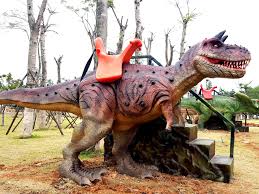|
The cost of a realistic animatronic dinosaur typically ranges from 5,000–10,000 for small models to 20,000–50,000 for large ones, influenced by six factors: size (bigger = pricier), materials (silicone over foam adds 15%), functionality (voice/sound systems cost extra 1k–3k), customization (premium designs hike prices by 20%–30%), brand reputation (top brands charge 15%–25% more), and accessories (environmental sensors add 500–2k). Basic Dinosaur Robot PricesLet’s cut straight to the point: a realistic animatronic dinosaur can cost anywhere from 5,000toover200,000.If you're working with a tight budget, a static or low-motion miniature model around 3 meters long might only set you back 5,000–10,000.But if you need something truly impressive—like a T. rex that’s 8 meters long, weighs 800 kg, and has 15+ dynamic movements—you’re easily looking at 60,000–100,000+. Here’s a quick breakdown based on size and movement complexity:
Foam skin is cheaper but looks less realistic and might only last 3–5 years outdoors. Silicone skin looks incredible, lasts longer (8–12 years with solid maintenance), but can add 15–30% to the total cost. Then there’s movement. Each additional motor (for jaws, eyes, neck, arms, tail) can add 800–2,000 per function. Sound systems? Another 1,000–3,000. That’s a whole different ballgame—walking mechanisms are complex and can push the price up by 40% or more. Oh, and don’t forget—shipping and installation for a large dinosaur can easily run 3,000–12,000, depending on where you are. So yeah, when someone quotes you “around $10k,” ask for the specs. Size & Material CostsA 3-meter-long mini T. rex (think kids’ birthday parties or small storefronts) uses lightweight foam and basic motors—you’re looking at 5,000–12,000. But bump it to 6 meters (museum or theme park level), and suddenly you’re talking 35,000–80,000. Why? Volume: a 6m dino needs 4x more steel for its frame than a 3m one, plus 3x the silicone skin (since surface area grows faster than length). Weight’s a big deal too—3m models top out at 200 kg, while 6m beasts hit 800 kg; heavier = more expensive shipping (1,500vs.5,000+) and installation (cranes cost $800+/hour). Foam’s the budget pick—3–8 per kg—but it’s fragile. A foam skin dino left outside 8 hours/day might need 1,500–3,000 in repairs yearly and only lasts 3–5 years. Silicone’s the premium choice—50–100 per kg—but it’s worth it. Silicone mimics skin texture flawlessly, withstands UV rays, and lasts 8–12 years with minimal upkeep. FRP? It’s the middle ground—15–30 per kg—durable but less flexible, costing 2,000–4,000 more than foam for a 6m dino but saving $5,000+ vs. silicone over 10 years. Here’s a side-by-side of how size and materials collide on cost:
Extra Features & FunctionsA basic pre-recorded roar module (3–5 sounds, 30-second loops) runs 500–1,200. But if you want dynamic audio—like a T. rex that growls louder when you approach or mixes roars based on movement—you’re looking at 2,500–6,000. These use motion sensors paired with AI sound algorithms, which adds 1,500–3,000 alone. Pro tip: Wireless speakers (vs. wired) cost 800–2,000 more but eliminate tripping hazards at events. A static dino with just head turns and eye blinks (5–7 motion axes) is cheap, but full-body motion (walking, tail swaying, claw gripping) is a whole other game. Adding a walking mechanism—hydraulic legs with terrain-adaptive sensors—can jerk the price up by 30–50%. For example: A 6m silicone T. rex that walks costs 75,000–120,000, while the same model without walking is 45,000–70,000. Each leg has 3–4 motors (800–1,500 per motor), plus pressure sensors (200–500 each) to prevent tipping. Even small movements add up: A tail that swings realistically requires 2–3 extra motors (1,600–4,500 total) and increases power consumption by 20–30% (so you’ll need a bigger battery, adding 300–800). Sensors turn “cool” into “interactive.” A basic touch sensor (on the nose or claws) that triggers a roar or movement costs 400–1,000 per sensor. Proximity sensors (to make the dino “notice” you when you’re 1–2 meters away) add 600–1,500 each. For museums, environmental sensors (temperature, humidity, UV) are critical—they protect the silicone skin and cost 1,200–2,500 per unit. These don’t just prevent damage; they extend the dino’s lifespan by 2–4 years (saving 5,000–15,000 in early replacements). Facial recognition modules run 3,000–8,000, and voice command setups (with noise-canceling mics) add 2,000–5,000. These features boost visitor dwell time by 30–60% at events—so if you’re charging 10/personentry,that’sanextra300–$600/hour in revenue. Here’s a quick hit list of how these features stack up:
Brand & Customization ImpactGeneric, no-name manufacturers might sell a 6m silicone T. rex for 45,000–60,000. But top-tier brands like DinoMation Inc. or PaleoTech Robotics? Same size, same specs—they’ll charge 70,000–90,000. Why the 40–50% markup? For starters, 5-year warranties (vs. 1–2 years from generic brands) that cover motor replacements (1,500–3,000 per fix) and software updates. Brands also invest in R&D—like patented motion algorithms that make movements 30% more lifelike—costing them 200,000–500,000 annually in development. That R&D gets passed to you, but it also means fewer breakdowns (generic brands have 2–3x more repair calls yearly) and better customer support (24/7 vs. 9–5). Standard steel adds 3,000–7,000 to a 6m dino; carbon fiber? 10,000–18,000. It’s lighter (cuts shipping by 1,000–2,000) and stronger (lasts 2–3 years longer), but you pay a premium. Or maybe metallic paint instead of standard silicone? That’s 1,200–2,500—it doesn’t affect function, but it makes the dino pop at night (boosting event attendance by 10–15%, according to event planners). Adding a facial recognition system (so the dino “recognizes” specific guests) runs 4,000–9,000. Integrating IoT sensors (to track foot traffic, temperature, or stress levels) adds 5,000–12,000—useful for museums tracking visitor engagement, but overkill for a birthday party. Even something simple like custom sound effects (replacing generic roars with a famous movie T. rex’s growl) costs 1,500–4,000 (licensing fees included). Here’s the kicker: Generic brands void coverage for custom parts; top brands charge 1,000–3,000 extra to insure custom work. And while customization makes your dino one-of-a-kind, it can also delay production by 2–4 weeks (vs. 1–2 weeks for standard models)—a big deal if you’re prepping for a launch event. |

